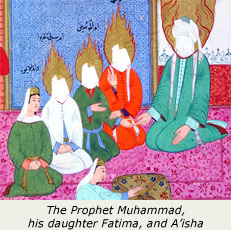Religious Sources
Religious sources are excellent sites for uncovering the important beliefs and frameworks that have influenced women’s experiences throughout history. Religious systems often provide a comprehensive way to think about aspects of life. Religions can provide information about how particular cultures organize their human relationships, how they make their personal and communal decisions, and how they interact with other societies.
Different religious systems throughout the world have taken widely varying positions on the role of women. For example, Hinduism and Confucianism are religious systems whose teachings and stories emphasize concepts of social hierarchy. In these religions, women are often in explicitly subordinate roles, spiritually and practically. In Christianity, Islam, and Buddhism, women and men are believed to have spiritual equality. Despite this spiritual equality, in Christian, Islamic, and Buddhist societies, patriarchal social norms frequently meant that women experienced practical inequality.
When encountering a historical religious text, keep in mind the imagery associated with women in that text. Are female characters portrayed as strong and wise counselors? Are they portrayed as a source of distraction or temptation for men who are pursuing salvation, enlightenment, or the moral good? Does the text provide guidelines for female behavior? Does it instruct adherents on how to conduct their domestic, sexual, or political relationships?

Similarly, it is important to ask whether the text indicates that individual historical women held important places of respect or power in that religion. For example, the Torah includes stories about figures such as Sarah, Rebekah, Rachel, and Leah, who played important roles in the history of the Israelites. In the Christian New Testament, Jesus’s mother Mary, Mary Magdalene, and Martha figure prominently in the story of Christ’s life. In Islam, portions of the Hadith (reports about what the Prophet Muhammad did and said) were conveyed by A’isha, Muhammad’s second wife. These provide important information about the women in Muhammad’s sphere. [See Analyzing Evidence: Religious Texts] These women all served as key role models for subsequent generations in each faith.
In addition to foundational religious texts, works of devotion and religious commentary also provide important information about women in world history. Again, one should consider whether the text was written by a woman. Were women the primary audience for the text? How does the text position women in relationship to the larger religious system? How does the text reflect the historical context in which was created?
In the case of religious objects, not unlike other instances of material culture, one should consider the creator of the object, the user, and the context of the devotional activity. For example in the Americas, participants of West African-diasporic religions symbolize spiritual devotion with ornate crowns, thrones, and altars that are decorated with symbols that invoke particular Orisha (deities). Thus, a crown that is yellow in color and includes water imagery most likely honors Oshun, a powerful female deity whose domain includes rivers.


